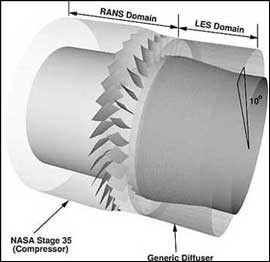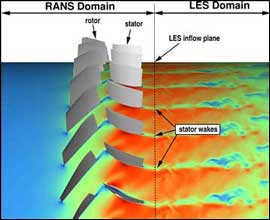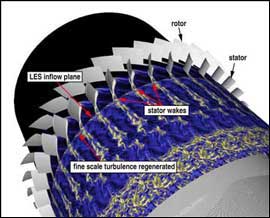|
|||
RANS
LES
Integration
Overview
Interface Dev.
Applications
Publications
People
Merrimac
Integration GroupOverview | Multi-code Interface Development | Applications | Publications | PeopleApplicationsGeometry for the NASA Stage 35 compressor coupled with a generic diffuser PDF. In a gas turbine, this geometry corresponds to the section, where the compressor is connected to the combustor. The flow enters the combustor through a diffuser. The performance of the diffuser is strongly dependent on the upstream flow. The coupled LES-RANS approach allows using a RANS approach in the compressor section and LES in the diffuser. Simulations of the interactions between the compressor and the diffuser have not been done before, due to the limitations of a single flow solver to simulate the entire domain. 
Integrated RANS-LES of the NASA stage 35 compressor and a diffuser: the compressor stage is computed with the RANS flow solver TFLO, the subsequent diffuser with the LES flow solver CDP. Here we see the axial velocity component at the 50% plane of the stator. The clip plane hides the diverging wall of the diffuser in the LES domain. At the interface, the turbulence that has been predicted in the RANS flow solver with a turbulence model has to be regenerated in the LES solution. Most prominent feature of the coupled simulation is the migration of the stator wakes into the LES domain. 

Integrated RANS-LES of the NASA stage 35 compressor and a diffuser: the compressor stage is computed with the RANS flow solver TFLO, the subsequent diffuser with the LES flow solver CDP. Here, we look at the vorticity magnitude distribution at the 50% clip plane of the stator. Again, we can identify the wakes of the stator passing the interface. The different description of turbulence in the two mathematical approaches is apparent. While on the RANS side the turbulence is modeled in a turbulence model and cannot be seen in the vorticity distribution, on the LES side the fine scale turbulence is regenerated and can be identified as small-scale structures in the LES solution. |


